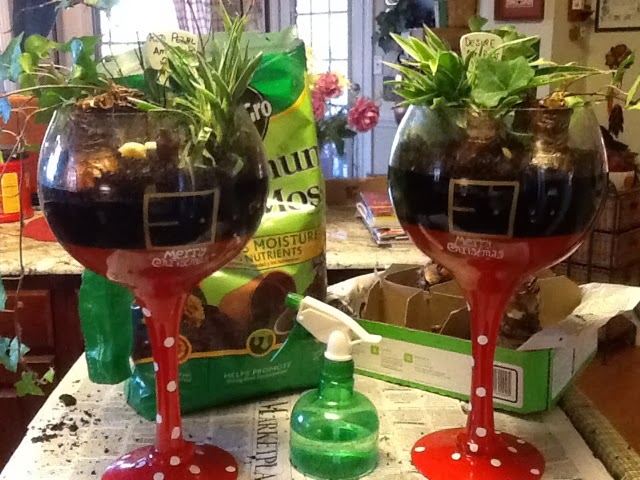Process, you say? What process?
Many people who receive a blooming amaryllis for a gift simply toss the bulb when the blooms fade. Being the primal garbage gardener that I am, I cannot do that. I have to at least give reblooming a try. I found this great step-by-step approach from the US National Arboretum that outlines how to make it work: click here to go there.
As I said, I leave the potted (spent) bulbs, with the strappy leaves intact, outside during the warmer months. This year, I snipped off the leaves, dug them up, and brought the bulbs inside mid-September, in order to give them a good 8-week resting period.
The bulbs spent this "time-out" in a divided box (originally made for Ball canning jars) in the guest bathroom tub (coolest place I could think of)...a room that stayed dark the entire period. There is no window in that room, and we did not turn on the light, or even enter it for the resting period.
I have been mulling over how to display them this year, wanting to do a little better than just individual plants in individual pots. I thumbed through one of my indoor gardening books, "Tabletop Gardens," by Rosemary McCreary (Storey Publishing, 2006) to get an inspiration, and then I revisited my Master Gardener Speakers Bureau binder on a presentation I gave on Containers for some ideas.
And then, during a retail therapy visit to Big Lots, I happened across these ginormous Christmas-themed wine glasses...clearly marked "FOR DECORATIVE PURPOSES ONLY." Inspiration, ideas, and opportunity all collided...and two of those 'glasses' came home with me.
My vision was to create two mirror-image tabletop container gardens for the dining room table Holiday centerpiece with three amaryllis bulbs each (they would eventually grow up to be the Thrillers), a tuft of a soft-bladed houseplant each (they would be the Fillers), and several long stems of English ivy, pulled from the over-run bed in front of our house (these would be the Spillers). I chose the wine glasses with the red and black Santa suit theme because I wanted to use as the center of this centerpiece tableau a wicker pot "cover" that is black with red accents...looks like Frosty the Snowman's top hat turned over...to contain a plain pot holding the largest amaryllis bulbs variety I have called 'Sydney.' Oh yes, Big Daddy (Sidney Lunn) is with us for every Holiday meal!
First, I gathered my materials: aquarium charcoal (acts as a filtering agent for containers that don't have drainage holes), sphagnum peat moss (a lighter planting medium than potting soil...holds moisture better), some small river rock (serves as a good 'anchor' base between the charcoal on the bottom of the glasses and the peat moss as the nesting medium for the bulbs and the companion plants) to support the emerging roots. I also got a narrow-spaded trowel and a pair of latex gloves...easier for me to work in than outdoor garden gloves. As I was working inside (too cold to work at my potting bench outside), I covered my workspace in newspaper. Meanwhile, I removed the amaryllis bulbs from their resting box to a large bowl filled with lukewarm water; I wanted to give them a good soak before planting them and get them well-hydrated after their 8-week resting period.
Then, I hand-washed and dried the containers. I placed a layer of charcoal (purchased at Petsmart, in the Fish section), followed by a layer of small river rocks. Then I scooped in a layer of peat moss.
I first placed the Fillers (to one side of one glass container, mirroring their placement in the other container), since they had the most-developed existing root structure and needed the greatest depth of planting medium (peat moss). I added the long stems of ivy (the Spillers), pushing the root-end deep into the peat moss, adding more as needed for support/anchorage.
Finally, I arranged three (well-hydrated) bulbs in each of the glasses and one large bulb in the single clay container. I added a bit of peat moss to cover any stray roots...but not too much. Amaryllis bulbs grow best if most of the bulb is showing. I added some larger river rocks on the top. Then I misted everything thoroughly, washing any stray planting media off the sides of the containers.
 |
| Ready to add the amaryllis bulbs |
 |
| Thrillers, Fillers, and Spillers added to containers |
To finish up for the time being, I moved all containers to the warmest, sunniest window in the house...and set a light on a timer to make sure they are receiving plenty of light to stimulate bloom-growth. I will keep daily tabs and will mist as often as needed, keeping the media moist but NOT soggy. Remember, there are no drainage holes in the glass containers, and the last thing I want is to develop root-rot.
And hopefully, I'll be posting pictures soon of beautiful blooms!

